Worksheets For Fun: Homework That Makes Sense.
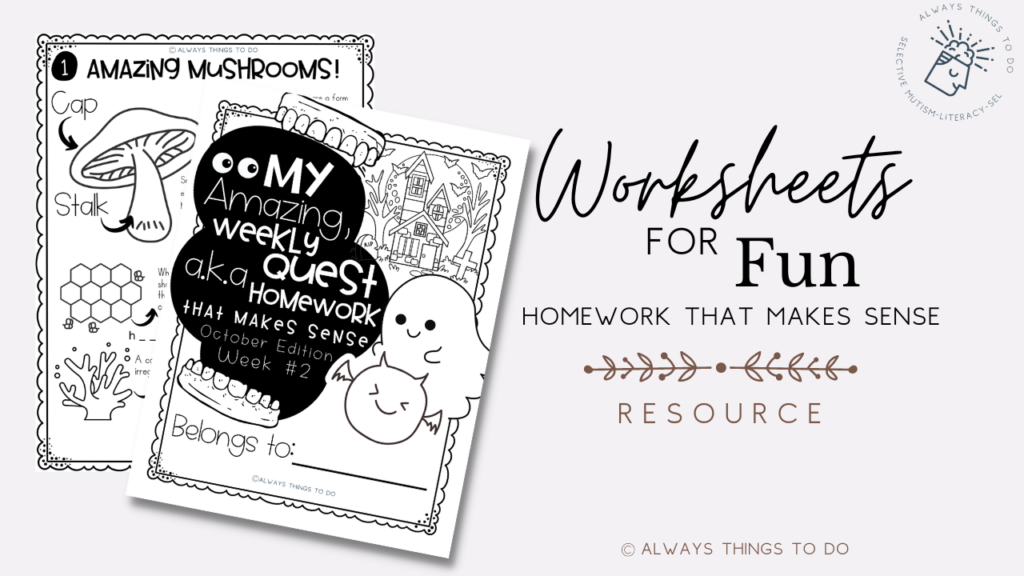
In this article, you will read about some fun alternatives to homework for second, possibly third graders (depending on where your kiddos are) – worksheets for fun. These fun worksheets were born from an idea that I had as a second-grade teacher, and that has been on my mind forever.
Every time the new school year begins, I just start getting overwhelmed by the idea of homework. The truth is I do believe in homework and parents of my second graders want homework too for their kids.
I’ve tried high frequency words worksheets, short reading comprehension stories, word lists to practice spelling and sentence writing, and so did you, perhaps.
It all sounds OK, but at some point, of their year it becomes so unnecessary, boring, and kids start complaining a lot…
My daughter went to second grade last year, and her ELA homework was primarily prepping for grammar and reading tests or lists of words to practice by selecting an option from a choice board: spelling the work with big and small letters, rainbow writing, creating a song, rhyming words, illustrating, and many others.
Because my child has anxiety around academic tasks (she has selective mutism anxiety), the ELA homework was somewhat a burden. Not only has it become boring after the first marking period, but my daughter also started selecting the same choices because, to tell the truth, “making a song” and “writing words in small and big letters” were either unachievable or senseless.
And therefore, worksheets for fun were created!
Why are “worksheets for fun” the best alternative to homework?
Without going into extremes like “no homework” in Finland (even though educational system in Finland is my heaven), I think of homework for 7–8-year-old second graders as an opportunity to extend learning at home.
It cannot be boring (like writing words in the alphabet order) or unachievable (like writing a song).
It should be short, easy-to-handle for a child with no parent support (parents are very busy), inspiring a kiddo to wonder, ask questions, search for answers. Most importantly, they need be fun!
“Fun Worksheets: Homework” are created with an idea that work at home should be manageable and inspiring. They cover many interesting activities that are naturally appealing to children:
- Scavenger hunt
- Drawing
- Creating stories
- Illustrating what they do
- Observing the world around them
- Reflecting on the favorite books they read, and many others!
Let’s face it, as teacher we still must provide children with homework, but we can make it different, inquiry based, totally manageable and, most importantly enjoyable!
What’s an idea behind monthly worksheets for fun?
So, here is an idea.
What if the homework worksheets revolve around one specific theme every month? In September, it’s back-to-school; October is centered around Halloween and pumpkins; October fun worksheets are related to Thanksgiving and pies; finally, December worksheets are based on reading favorite books, writing stories and drawing.
Let’s look at the month of September.
It’s a busy time for a teacher. For kids, it’s the time to talk about themselves, share their expectations for the coming school year, and enjoy “visit-the-farm” season and explore beautiful nature. For teachers, it’s the opportunity to get to know students, do some interest inventory and, perhaps, conduct a baseline writing assessment to plan for further writing instruction.
Guess what?! Would it be cool if all this were possible just by using greatly designed homework worksheets?
Let’s say there four weeks you have in September (probably fewer if you start school after the Labor Day). I’m still giving homework only four days a week (on Mondays, Tuesdays, Thursdays, and Wednesdays, no homework on Fridays and over the weekend).
What it means, on Friday morning I collect whatever homework I assigned and assess it the way I choose: “Great Job!” stamps, stars, and checkmarks (nothing serious) with some general comments for a child.
I do it for every week of the month. My goal is to have kids busy, engaged in something interesting, practicing some writing and writing, being inspired to learn independently and spend time outside.
Let me show you how you can do it.
The first week, these worksheets for fun, are focused on students and baseline writing.
- Day 1: Ask the kids to tell you all about themselves. Not only is it fun, but you can also keep it in your folder as an interest inventory file!
- Day 2: Ask students to share their expectations for this school year! You also can keep it as a file for Domain 4 end of the year artifact.
- Day 3: Learning interesting new words are important. Let’s dedicate one day of the week to learning a new word! Done!
- Day 4: What about baseline writing assessment? Ask the kids to tell you where they went over the summer break. This writing sample will serve as a perfect initial writing assessment and will give you the sense of where you kids are in writing. Keep it in your file, too!
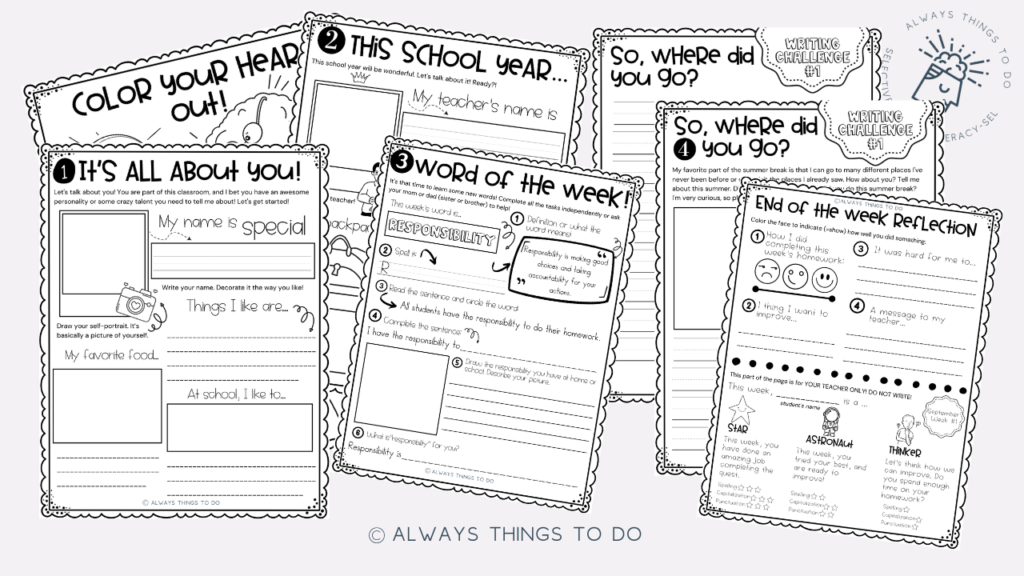
Here is week 2!
- Day 1: Let’s kick off with the short read about the monster who didn’t clean after himself! Kids do fun activities and learn words.
- Day 2: Since it’s September, the weather is probably beautiful! How about a farm? Kids create a list of things they can see on the farm and describe the activities they can do there!
- Day 3: It’s the time to learn a new word! This week’s word is “observe!”
- Day 4: Send the kids outside to collect a rock. Ask them to study it. They draw the rock and describe it. You can extent this activity by offering students to find books about rocks and bring them to class or learn something new independently!
Not to forget, every week should finish with some reflection. Absolutely. As a teacher you can also provide comments on the reflection sheet!
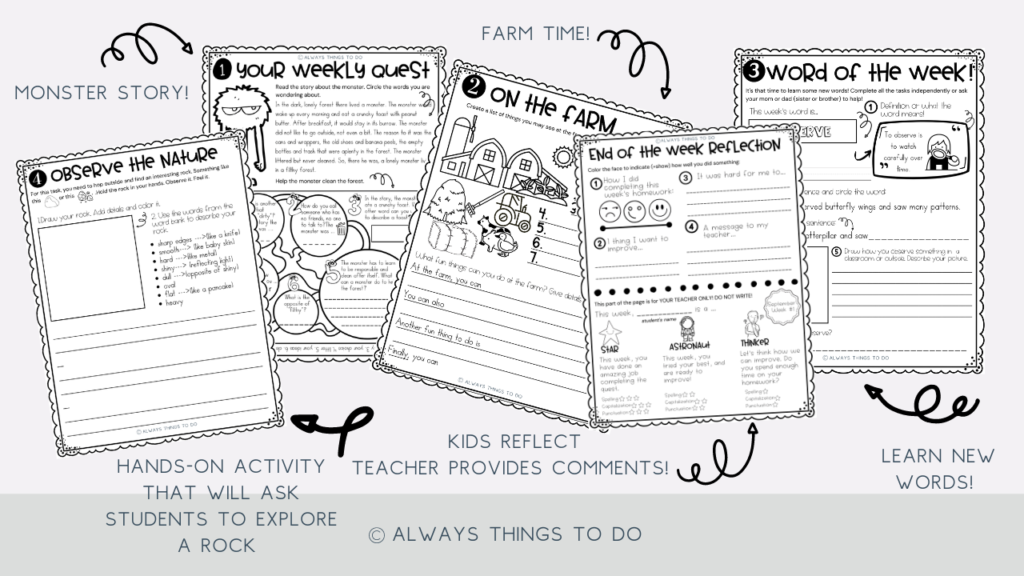
During the month of September, students:
- learn 4 new vocabulary words (responsibility, observe, charming, edible),
- create lists,
- read and write,
- observe and describe,
- create a map of the farm,
- learn about mushrooms and relate them to shapes.
How fun is it?!
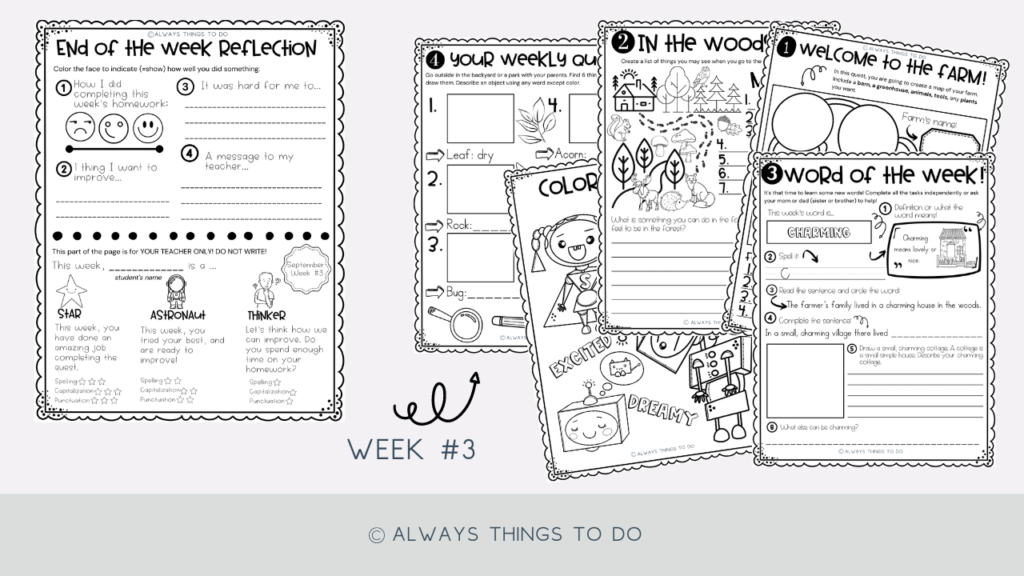
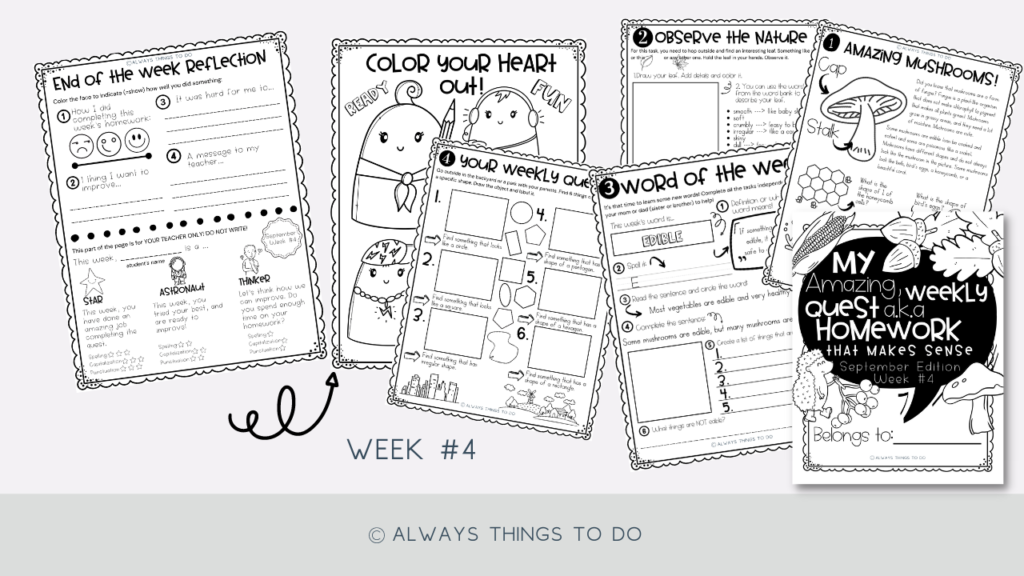
How to use worksheets for fun.
In case you already have your game plan for this year’s homework, there are other things you can do with these fun activities. Worksheets for fun can be used as:
- “I’m done” work for early finishers
- One of the stations during ELA time
- Differentiation material for those kiddos who love to explore and do things independently
And do not worry, you do not need a colored printer. All the worksheets are black and white, and direction are straightforward.
If you find this idea interesting, check out the September – December monthly worksheets for fun in my store.
What to try the first week for free? Click here!
If you like this post, you may find other post educational and helpful. My recommendations are:
- Reading Comprehension Worksheets: The Basics of Text Comprehension to Teach.
- What Are My Strengths? Individual & Group Activities for Social-Emotional Education in “My Strengths” Journal.
- Routines For School: How To Help a Reluctant & Anxious Child Thrive in Daily Routines and Reading.
- What Mindfulness Is In a Classroom: Must-Have Activities.
- What Is Self-Awareness and How To Teach It?
- How to Use Get To Know You Questions to Build Self-Awareness.
- Follow my TpT store for more fun resources!


